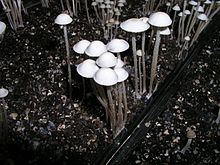Panaeolus cambodginiensis
| Panaeolus cambodginiensis | |
|---|---|

| |
| Scientific classification | |
| Domain: | Eukaryota |
| Kingdom: | Fungi |
| Division: | Basidiomycota |
| Class: | Agaricomycetes |
| Order: | Agaricales |
| Family: | Bolbitiaceae |
| Genus: | Panaeolus |
| Species: | P. cambodginiensis
|
| Binomial name | |
| Panaeolus cambodginiensis Ola'h &
R.Heim | |
| Synonyms | |
| |
| Panaeolus cambodginiensis saprotrophic | |
|---|---|
| Edibility is psychoactive | |
Panaeolus cambodginiensis is a potent
Description
The cap is less than 23 mm across, with a convex shape and an incurved margin when young, expanding to broadly convex. The cap surface is smooth, often cracking with irregular fissures. The gills are gray to black. The stem is 5 to 10 centimetres (2.0 to 3.9 in) tall, 4 mm thick, and slightly swollen at the base. The
It can be differentiated from the similar Panaeolus cyanescens by microscopic characteristics.
Distribution and habitat
Panaeolus cambodginiensis is mushroom that grows on dung of water buffalo. It was first described from Cambodia and is widespread throughout the Asian subtropics and Hawaii.
Alkaloid content
Strongly bluing species. Merlin and Allen (1993) reported the presence of psilocybin and psilocin, up to .55% and .6%, respectively.[2]
See also
References
- ^ Weeks RA, Singer R, Hearns WL (1979). "A new species of Copelandia". Lloydia. 42 (5): 469–74.
- ISBN 0-9610798-0-0.
- Stamets, Paul (1996). Psilocybin Mushrooms of the World. Berkeley: Ten Speed Press. ISBN 0-9610798-0-0.
